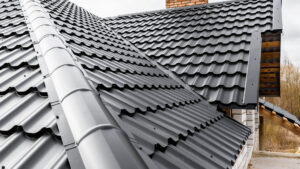Roofing is the process of covering the exterior of a building with a protective layer of material such as metal, wood, or clay. It protects the interior of a home from rainwater and is essential for preventing mold and mildew. In a typical roofing project, the roof covering will last between 50 and 100 years. The type of material used depends on where it will be installed. Typically, a slanting roof will have a slanting edge.

Gable walls are triangular portions of a home that extend from the eaves to the apex of the roof. The gable walls have a centerline called the ridge, or verge. Several sections of a roof will meet at a hip and valley, and each of these sections will have a unique structure. Roofing systems are also arranged to prevent water from pooling in the eaves or causing damage to the interior.
Asphalt shingles are the most common roofing materials and cost between $1.50 and $2.50 per square foot. These roofs typically last about ten years. Built-up roofing is one of the oldest types of flat roofs and is composed of several layers of roofing felt, impregnated with asphalt. The layers overlap and are sealed with hot tar. Finely crushed stone is embedded in the asphalt, creating a durable roof. A high-quality roof will withstand wind and rain.
Roofing nails are used to secure shingles to the roof. Roofing nails are generally made of aluminum, stainless steel, or copper. The length of the shank depends on the type of roofing material. Asphalt and fiberglass shingles, for example, require 1-inch nails. Wood shingles, on the other hand, need longer nails. However, if you do decide to use longer nails, it is advisable to buy nails in lengths of one inch.
Another common type of roof is thatch, which is made of plant stalks and laid in layers. This type of roofing is durable and will not deteriorate as quickly as shingles. If you want to get a unique, natural-looking roof, try using this type of material. While this may not be the most durable type, it is a natural and environmentally-friendly alternative to asphalt shingles. The only disadvantage to this type of roofing is that it is very heavy and will need a sturdy structure to keep it in place.
Different types of roofs have different purposes. One purpose is to protect against rain, but other purposes may require a roof that admits sunlight and other elements. Roofing can provide additional living space, too. If you’re looking for a roof that protects you from extreme temperatures, this type of roof may be right for your house. You might also want to consider the shape of your roof. This can help you choose the right material. A roof can be shaped like a triangle, so choosing the right material for your home is important.
In addition to preventing ice dams and damaging your roof, you can avoid major problems with your roof by identifying the causes of them. Rain can cause a variety of issues in your home, including rot in the roof, mold and mildew growth, and even the structure of a building. In addition, extra moisture can also cause a variety of problems in your interior, including electrical systems. Also, high wind damage can damage a roof, so it is important to keep your gutters clean.
Slate roofs are highly durable and resistant to extreme temperatures and small branches. Slate is also a fire-resistant roofing material. It’s also quite affordable, costing between $9 and $20 per square foot, and can last anywhere from fifty to 200 years. Slate roofing is typically made of natural quarried slate, while synthetic slate is less expensive. However, it’s important to note that natural slate is not as long-lasting as synthetic slate, so you’ll have to make sure you hire a reputable roofer to complete the job.
Another important consideration is drainage. A roof’s drainage will affect its ability to shed water, so you should carefully consider drainage when designing your new roof. The slope is a common way to measure slope, and it’s measured in inches for every foot of horizontal distance. A five-in-12 slope will rise five inches for every foot. The slope is important because water will seep into the structure, which can cause the entire structure to collapse. It’s also important to ensure that the structure underneath the roof is strong enough to support the weight.
Wood roofs are an attractive option but are relatively expensive. Wood roofs are not very long-lasting and are not recommended for homes in areas with extreme moisture or wildfire risk. Despite its drawbacks, wood roofs are still a popular choice for luxury homes. Cedar and redwood are commonly used to build wood roofs. Wood shingles and shakes are thick wedges of wood with a rough texture. If you have a large roof area, you’ll want to check out the shingles and wood shakes.